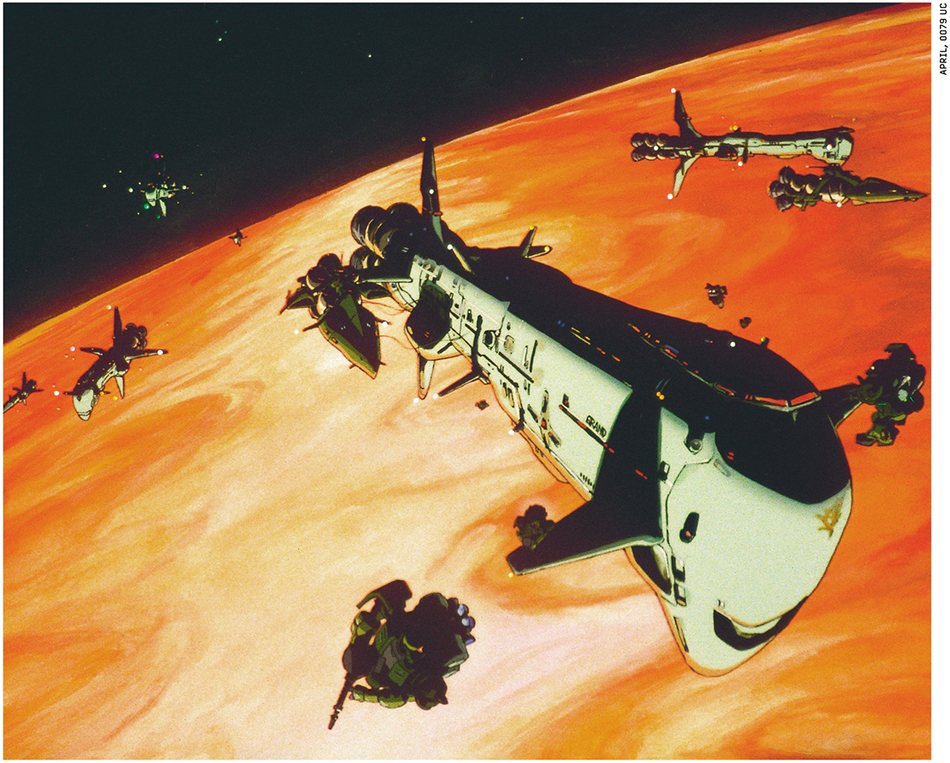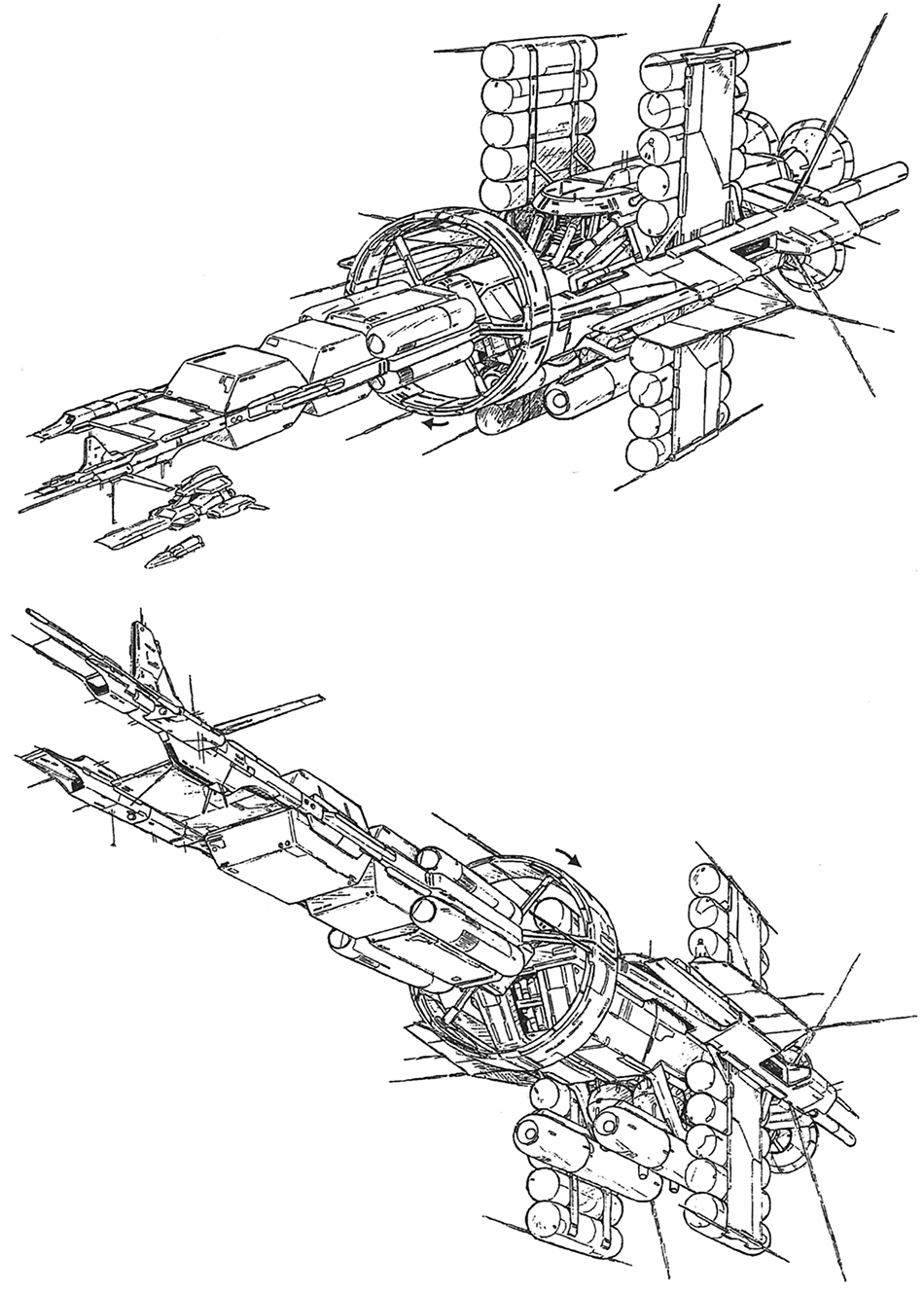JUPITER FLEET


Zeon’s Helium Convoy in Jovian Orbit as depicted in MS ERA. Under the conditions and terms decided by the Antarctic Treaty, mutual nonaggression was agreed upon for the collection and transportation of Helium-3, the propellant for spaceships.
Nuclear fusion reactors of today are based on Helium-3 and deuterium. Helium-3 is a rare element, accounting for only 0.015% of all helium. Moreover, it is almost entirely non-existent on Earth. When thermonuclear reactors were first put into practical use, Helium-3 was mined from the lunar surface. The Helium-3 contained in the solar wind had penetrated the lunar rocks over extended periods, and the strata just underneath the surface contained it. However, these amounts were not nearly enough, despite being more abundant than on Earth. So Jupiter, with its atmosphere containing mainly Helium-3, was chosen as a mining site.
Jupiter is a distant planet, some 800-million kilometers from Earth. However, the inexhaustible supply of Helium-3 and deuterium was still quite appealing, even despite the distance. Mining at Jupiter had been going on since before the transition to the Universal Century. Still, it wasn’t until the reorganization of the Jupiter Energy Development Fleet (sometimes abbreviated as the Jupiter Energy Fleet) into the Jupiter Development Enterprise Group in 0010 that it reached the scale it has today. It is safe to assume that full-scale mining at Jupiter did not begin until this semi-private, semi-governmental organization was established.
The Jupiter Development Enterprise Group is under the jurisdiction of the Federation Forces Staff Council of the Federation government. This is because Helium-3 is not only needed for space development and maintaining Earth’s economy and lifestyle but is also regarded as a “strategic material” that is essential for the operation of military vessels. However, the Federation Forces are only responsible for escorting and quarantining the fleet within the Earth Sphere and are not allowed to conduct inspections or audits that may interfere with its operations. This means that the Jupiter Development Enterprise Group is politically neutral and has an independent internal power structure and operating philosophy.
Due to these circumstances, Enterprise Group staff were never considered to be members of the Federation government. As such, even after the independence of Side 3 and the secession from the Federation through a declaration of a Principality, these “foreigners” were often dispatched to Jupiter as staff.
Large ships using nuclear pulse propulsion were used to travel between the Earth Sphere and Jupiter. These ships were known as “interplanetary helium transports” or “helium mining ships.” Although the ships were several kilometers in length, they consisted mostly of power units and helium tanks, with living quarters, factory blocks, and a bridge concentrated in the ship’s center.
To ensure safe travel, the ship does not sail alone but in convoy with several other ships to prepare for unforeseen circumstances. Due to the fact that the journey to and from the Earth Sphere takes roughly a few years, living in a closed environment for extended periods leads to psychological anxiety, so the captain of the helium transport convoy is chosen for their ability to lead and make proper decisions in the case of an emergency.
A small station has been established in satellite orbit around Jupiter as a base for mining.
The Jupiter Fleet is the more common name for this helium transport convoy. However, this refers not only to those dispatched by the Jupiter Enterprise Development Group as mentioned above but also to fleets dispatched by the Principality on their own from the 0070s through the One Year War.
The Principality decided to send its own mining convoy to Jupiter after its secession from the Federation following its declaration as a Principality in 0069. The Jupiter Enterprise Development Fleet operations were politically neutral, but the Helium-3 to be mined was under Federation government control. Naturally, being a strategic material, Helium-3 was included in the economic sanctions embargo that had been in place since 0059, the year following the Republic’s declaration of independence. The Republic’s energy supply was primarily solar, so there was no serious impact on the lives of its citizens. Helium-3, which was mainly supplied for military use, was believed to have been purchased from lunar city groups in exchange for the sale of surplus solar power. However, the rapid buildup of their armed forces after declaring themselves a Principality led to a shortage of Helium-3 within the country, and the Principality found itself in a dire need to secure this strategic material.
It has been said that the Principality’s first fleet of ships departed in 0070 and returned in 0074. While no detailed records remained, it is also noted that in addition to shipwrecks due to hull issues, the mental derangement or delirium of the crew that occurred on many of the ships was considered a problem. While it is unclear how the Principality managed to solve these issues, but from this point forward, they dispatched a fleet of ships on a regular basis and were able to maintain a stable supply of Helium-3 on their own.
Within the Principality, Helium-3 was considered a strategic material, so the Jupiter Fleet was operated by the military. In fact, the crew aboard the transports were given military ranks. A captain in the Principality’s Jupiter Fleet, Challia Bull, returned to the Earth Sphere during the One Year War and was recorded as a Lieutenant.
The Antarctic Treaty signed between the Federation and the Principality during the One Year War included a provision of nonaggression towards the Jupiter Fleet. With the spread of thermonuclear reactors, Helium-3 had become an essential energy source for the survival of the human race.
After the end of the One Year War, the Federation Forces also placed importance on Helium-3 as a strategic material, so they would sometimes add transport ships belonging to their forces to the Jupiter Enterprise Development Group’s fleet, having them commanded by military personnel. The Jupiter Fleet dispatched like this is known to have had the Jupitris-class interplanetary helium transport as its flagship as it returned to the Earth Sphere in 0087. The Captain of the Jupitoris is Lieutenant Paptimus Scirocco, who also served as the fleet captain.

◎ JUPITRIS-CLASS INTERPLANETARY HELIUM TRANSPORT: Commissioned after the One Year War, this 2-kilometer long hulk is equipped with 5 nuclear pulse engines. The illustration above shows the first ship in the class, the Jupitris. At the forefront of the illustration (at the bow of the ship) is the Alexandria-class space cruiser for reference. In the center of the hull are the Helium-3 transport tanks and sandwiched between them is the factory block.

[U.C.0010]
The Jupiter Energy Fleet is reorganized as the Jupiter Development Enterprise Group
[U.C.0070]
The first Jupiter Fleet departs the Principality of Zeon
[U.C.0074]
The first Jupiter Fleet returns to the Principality of Zeon
[U.C.0077.07]
The Principality’s Special Forces, armed with 12 newly developed mobile suits, attack the 33rd Transport Fleet en route to Jupiter. 12 transport ships filled with deuterium are seized and the Federation Forces escort convoy is destroyed.¹
[U.C.0079.12.10]
The Federation Forces 59th Unit is assigned to escort the Jupiter Fleet. The Federation’s Jupiter Fleet comes under attack by the Principality of Zeon in violation of the Antarctic Treaty.
[U.C.0079.01.31]
The Antarctic Treaty is signed. One of the provisions states that there is a mutual nonaggression clause towards the Jupiter Fleet.
[U.C.0082]
Johnny Ridden attacks the Federation’s helium fleet in the Jovian Sphere.²
[U.C.0087.04.29]
The Federation government announces a reduction in the scale of planetary development following the return of the Jupiter Energy transport Jupitris to the Earth Sphere.
[U.C.0089.03.15]
The Jupiter Energy transport resumes. Jupitris II departs. Judau Ashita and Roux Louka head for Jupiter.
¹ This incident is depicted in the short story TOP GUNDAM -Surprise Attack- by Hiroshi Yamaguchi. It was serialized in B-CLUB Visual Comic Mobile Suit Gundam 0080 War in the Pocket Vol.1.
² This is depicted in the manga Jupiter Mirage and the version of the character that appears in this story has nothing in common with the MSV counterpart aside from the name.





